
About UsThe Numismatic Bibliomania Society is a non-profit organization promoting numismatic literature. For more information please see our web site at coinbooks.org SubscriptionsThose wishing to become new E-Sylum subscribers (or wishing to Unsubscribe) can go to the following web page link MembershipThere is a membership application available on the web site Membership Application To join, print the application and return it with your check to the address printed on the application. Membership is only $15 to addresses in the U.S., $20 for First Class mail, and $25 elsewhere. For those without web access, write to: David M. Sundman, Treasurer AsylumFor Asylum mailing address changes and other membership questions, contact David at this email address: dsundman@LittletonCoin.com SubmissionsTo submit items for publication in The E-Sylum, just Reply to this message, or write to the Editor at this address: whomren@gmail.com
BUY THE BOOK BEFORE THE COIN |
- WAYNE'S WORDS: THE E-SYLUM NOVEMBER 17, 2013
- CHARLES DAVIS NOVEMBER 16, 2013 SALE RESULTS
- NEW BOOK: A CABINET OF CENTENNIAL MEDALS
- NEW BOOK: CIVIL WAR STAMP ENVELOPES, 2ND PRINTING
- NEW BOOK: COINS AND COLLECTORS PART 2
- NEW BOOK: PHILATELIC LITERATURE OF THE 19TH CENTURY
- BOOK REVIEW: NEW JERSEY STATE COPPERS
- QUERY: EUROPEAN COINAGE 1500–1600 CATALOG SOUGHT
- QUERY: INFORMATION ON 'STORY OF MONEY' CARDS SOUGHT
- MARJORIE OWEN HENDERSHOTT 1924-2013
- NOTES FROM E-SYLUM READERS: NOVEMBER 17, 2013
- MORE ON COLLECTOR JOHN G. MILLS
- COLONIAL CURRENCY ON PINS AND NEEDLES
- KING OF SIAM SET PRINTING PLATE BOOK SOUGHT
- ENGRAVER JOHN BOLEN'S BRAZIL NUT CARVING
- MORE ON EDWARD SAWYER'S INDIAN MEDALS
- SOME NEW COIN DESIGNS: NOVEMBER 17, 2013
- AUCTION REVIEW: NUMISMATIK LANZ DECEMBER 2013 SALE
- TOM KAYS' NUMISMATIC DIARY: NOVEMBER 17, 2013
- BOOKS ON THE PROGRESSIVE LABOR EXCHANGE MOVEMENT
- SRI LANKA ISSUES NEW COMMEMORATIVE 500 RUPEE NOTE
- OLYMPIC COMMITTEE NIXES MEDALS STRUCK FROM CANCELLED DIES
- TWO NEW NUMISMATIC MUSEUM GALLERIES PLANNED IN INDIA
- MEDAL SLEUTH LOCATES MILITARY CROSS FAMILY MEMBERS
- 1640 BAY PSALM BOOK TO BE SOLD BY SOTHEBY’S
- 2014 COIN OF THE YEAR WINNERS ANNOUNCED
- LEBANESE BANKNOTE MISSPELLS 'INDEPENDENCE'
- THE 1859 JOHN J. FORD BOSTON SCHOOL MEDAL
- FEATURED WEB PAGE: A CENTENNIAL CABINET
Click here to access the complete archive
To comment or submit articles, reply to whomren@gmail.com
WAYNE'S WORDS: THE E-SYLUM NOVEMBER 17, 2013

New subscribers this week include Mike Clark, courtesy of Dave Perkins, Evelyn Mishkin, courtesy of Dave Bowers, Nathan Gudenkauf, Jeff Dickerson and Roy G. Welcome aboard! We have 1,684 email subscribers, plus 250 followers on Facebook.
This week we open with a post-sale report from literature dealer Charlie Davis, followed by four new books, one review and some new queries from researchers.
Other topics include Marjorie Hendershott, John G. Mills, the King of Siam set, books on the U.S. Labor Exchange movement, and word that the Olympic Committee has squashed the making and sale of medals stuck from cancelled U.S. coin dies.
To learn more about Dave Bowers' new book, the Story of Money cards, currency on pins and needles, John Bolen's Brazil nut carving, a Fenian Brotherhood token, and the Marine Presidential Helicopter Squadron challenge coin, read on. Have a great week, everyone!
Wayne Homren
Editor, The E-Sylum
CHARLES DAVIS NOVEMBER 16, 2013 SALE RESULTS
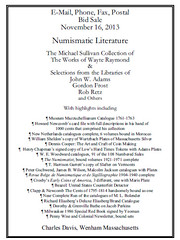 Our sale, which was comprised of consignments from Michael Sullivan, John Adams, and the estate of Gordon Frost realized $134,000 after the buyer's premium. United States Coin Company and W. Elliot Woodward catalogues received the most bids, but the standouts were Adams' Morocco bound set of New Netherlands catalogues ($6,325), USCC Sale 36, one of three known copies with plates (also $6,325), Howard Newcomb's large cent card file (again $6,325), 2 volume catalogue of the Mazzuchellum Museum ($4,830), and John Ford's set of the Coin Collector's Journal ($3,565). The prices realized list will be posted on our web site www.numisbook.com as will conditions for purchasing unsold lots
Our sale, which was comprised of consignments from Michael Sullivan, John Adams, and the estate of Gordon Frost realized $134,000 after the buyer's premium. United States Coin Company and W. Elliot Woodward catalogues received the most bids, but the standouts were Adams' Morocco bound set of New Netherlands catalogues ($6,325), USCC Sale 36, one of three known copies with plates (also $6,325), Howard Newcomb's large cent card file (again $6,325), 2 volume catalogue of the Mazzuchellum Museum ($4,830), and John Ford's set of the Coin Collector's Journal ($3,565). The prices realized list will be posted on our web site www.numisbook.com as will conditions for purchasing unsold lots
Charles Davis
P.O. Box 547
Wenham, MA 01984
Tel: (978) 468 2933
Fax: (978) 468 7893
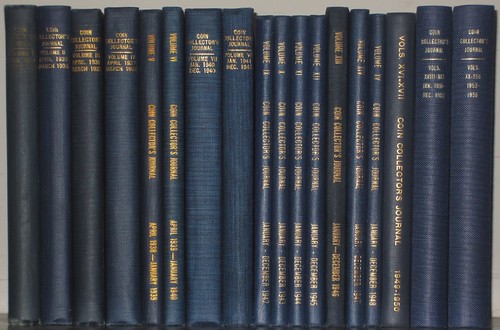
NEW BOOK: A CABINET OF CENTENNIAL MEDALS
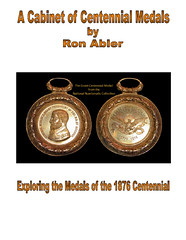 Ron Abler announces the limited-access (invitees only) pre-publication draft of his new iBook, A Cabinet of Centennial Medals: Exploring the Medals of the 1876 Centennial online at
www.CentennialMedals.com. He invites E-Sylum subscribers to view the draft book and offer suggestions, additions, corrections, kudos, and criticism through the “Contact” page or at
tritoncollect@atlanticbb.net. Contributions will be acknowledged in the book as they are received and implemented.
Ron Abler announces the limited-access (invitees only) pre-publication draft of his new iBook, A Cabinet of Centennial Medals: Exploring the Medals of the 1876 Centennial online at
www.CentennialMedals.com. He invites E-Sylum subscribers to view the draft book and offer suggestions, additions, corrections, kudos, and criticism through the “Contact” page or at
tritoncollect@atlanticbb.net. Contributions will be acknowledged in the book as they are received and implemented.
The author gratefully acknowledges the generous assistance of the Central States Numismatic Society, who awarded a significant monetary grant that enabled Ron to purchase needed software for the website, pay for the publication rights to the images of medals in the collection of the American Numismatic Society, and develop a future chat room for the iBook where collectors can collaborate with each other.
Ron plans to share the book at no charge in exchange for the collaborative cooperation of his readers. His goal for A Cabinet of Centennial Medals is to produce, through interactive collaboration with fellow collectors, authors, and dealers, a catalog of Centennial medals (ultimately to include tokens, badges, and other exonumial material) that is as complete, current, and accurate as technology and teamwork can achieve.
Ron defines an iBook (Internet book) as a cross between a simple website and a traditional paper book. It consists of typical website pages such as Home, About this Website, and Contact. In addition, three pages (Introduction, Cabinet, and Appendices) provide access to the book itself, which consists of 29 PDFs (so far) that can be browsed, downloaded, saved, and/or printed, as the reader chooses. Each file is formatted for standard 8 ½ -inch by 11-inch paper. Once printed, the pages can be drilled for a standard three-ring binder or bound in any other manner desired.
Whether accessed on the website or from the reader’s own downloaded files, A Cabinet of Centennial Medals offers a variety of advantages over traditional paper books. First and foremost, it is intended and designed to be a living document maintained in real time by the community of Centennial collectors. Since it is digital, additions and corrections can be made as they are discovered and identified. The numbering system is designed specifically to permit the addition of previously unknown (at least to the author) medals that can be inserted in the correct location without disrupting or disordering previously numbered entries.
Inevitable spelling and grammatical errors will be corrected as they are discovered. Furthermore, the second and subsequent “editions” of an iBook need not wait until a sufficient number of backlogged changes justifies the cost and distribution of a corrected and expanded edition. In order to accommodate the dynamic nature of such an undertaking, Ron will maintain careful configuration management that will track all changes online and in the footer of every page so that readers can decide for themselves whether and when to download revised files and update their own copies of the book.
What better team could Ron hope for than the readers of The E-Sylum?
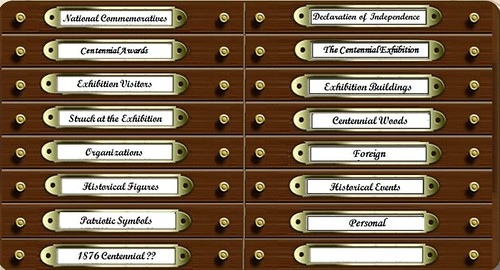
One thing I would like to see is a future print-on-demand option through something like Lulu.com. As much as I live online, I still fear for the longevity of electronic-only works, and would feel better knowing that hardcopies exist in the libraries of many collectors and institutions. -Editor
Ron adds:
My objection to the print-on-demand sites like Lulu is that, while the up-front costs are reasonable compared to underwriting a traditional first-edition print run, many of those costs are charged again every time an author wishes to make a change and “republish.” Print-on-demand does not solve or avoid the underlying drawback of any paper book: it is outdated on the day of its publication, and it is prohibitively expensive to update it. That’s why there are so many valuable and important references that are out of print and never reprinted. Great for bibliomaniacs, but not so good for the rest of the numismatic collecting community.
That said, I realize that many collectors prefer a paper catalog, even if out of date. After all, you couldn’t bring an electronic Sears catalog into the outhouse, could you? I acknowledge also that there is an intrinsic value to a paper book, and my work should be preserved in at least one tangible form. I will definitely consider a Lulu version of the limited-edition that my local printer wants to undertake.
To visit the book's web site, see: www.centennialmedals.com
NEW BOOK: CIVIL WAR STAMP ENVELOPES, 2ND PRINTING
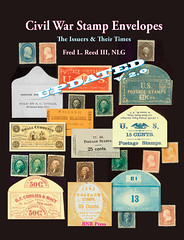 Author Fred Reed announces that the hardcover edition of his book, Civil War Stamp Envelopes, the Issuers and Their Times, was a complete sellout. "Since we had to go back on press to fill the many orders still at hand, we took the opportunity to swap out some illustrations, amplify some text, and clarify some of the cataloging making V. 2.0 of this book EVEN BETTER," Reed stated. He thanked collectors Joe Boling, David Gladfelter, Chuck Armstrong and Art Paradis for their insightful comments that are incorporated into this second printing.
Author Fred Reed announces that the hardcover edition of his book, Civil War Stamp Envelopes, the Issuers and Their Times, was a complete sellout. "Since we had to go back on press to fill the many orders still at hand, we took the opportunity to swap out some illustrations, amplify some text, and clarify some of the cataloging making V. 2.0 of this book EVEN BETTER," Reed stated. He thanked collectors Joe Boling, David Gladfelter, Chuck Armstrong and Art Paradis for their insightful comments that are incorporated into this second printing.
"This second printing of my new book parallels the rollout of my companion work on Civil War encased stamps," Reed noted. The 484-page first printing of his Civil War Encased Stamps, the Issuers and Their Times appeared in December 1994, and then an enlarged 560-page second printing came out in August 1995. Since this new UPDATE V. 2.0 of the stamp envelope book is a revision, though, this new printing additionally has slightly different graphics on front cover and spine to easily distinguish it from the first printing on a collector's bookshelf. It also has a different ISBN to further differentiate it from the earlier printing.
"We didn't do this to necessarily sell more books," Reed reflected. "Purchasers of the first printing have the 'whole story' about this long neglected field, including all the rarity information and pricing information. The updated printing just presents that story in slightly finer detail in several places," and includes an additional section "How to Use This Book." Price of the 672-page hard cover book remains the same, $79.95 (plus $10 per book postage, boxing, and insurance). Orders for the book may be sent to Fred Reed, P.O. Box 118162, Carrollton, TX 75011-8162.
Fred adds:
To show how common this is in publishing, I Googled "revised first edition" in quotation marks so it would only call up entries with that exact phrase and I got nearly a quarter million hits (everything from The Hobbit to Engineering Thermodynamics)
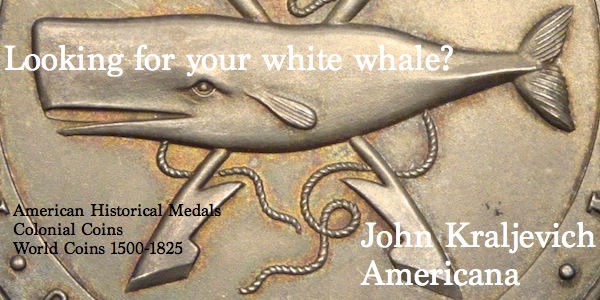
NEW BOOK: COINS AND COLLECTORS PART 2
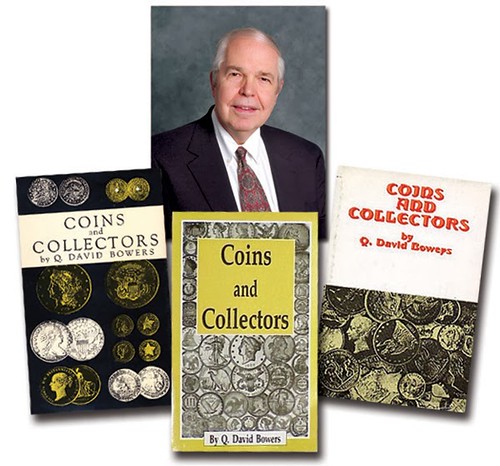
As you read these words I am busy writing a new book, Coins and Collectors Part 2. Next year, 2014, will be the 50th anniversary of the first book I ever wrote, Coins and Collectors. I was in my early twenties at the time, but was already recognized as one of America’s leading dealers, having been in the trade since 1953, when I started on a part-time basis in high school.
While collecting coins and dealing in them I found a special interest to be numismatic history. At the time there was a world of interesting information available at virtually no cost. Back issues of The Numismatic Scrapbook Magazine, The Numismatist, auction catalogs of B. Max Mehl, Stack’s and other firms, the American Journal of Numismatics and reference books were for the most part very inexpensive. In the early days many of these were gifted to me by members of the Wilkes-Barre Coin Club. There was no market for them.
By 1964 there was a great deal of interest, and scarce auction catalogs could sell for a few dollars or more, quite a bit more when it came to those put out by the Chapman brothers and illustrated with photographic plates, for example. I enjoyed reading the magazines in particular, as year by year the scenes of numismatics unfolded. Along the way I learned many interesting stories. This led me to write Coins and Collectors, an assortment of things I found diverse and interesting -- from the 1955 Doubled Die cent in which my business partner Jim Ruddy and I were very involved in the marketing arena to stories of old-time coin dealers, the Columbian Exposition and the coins there, and more.
Coins and Collectors sold quite well, and in time we reprinted, probably with a total press run of fewer than 10,000 copies, however. It was picked up by Crown Publishers, a mainstream publisher and distributor, given a new cover, and offered at a discount price all over America. I was told that over 100,000 copies were sold! If so, this probably was the best-selling rare coin book of its time, exceeded only by the annual Guide Book of United States Coins. Now, Coins and Collectors Part 2 will have new stories, new adventures, and new insights -- as so much has happened since then. I do not have a deadline in completing it as in this way I can’t be late! However, I do hope to have the copy in the hands of Whitman Publishing by the end of the year, which indicates that it might be available in spring 2014. Stay tuned.
To read the complete article, see: From The Desk Of Q. David Bowers: Coins And Collectors Part 2 (stacksbowers.com/Blogs/from-desk-of-q-david-bowers-coins-and.html)
NEW BOOK: PHILATELIC LITERATURE OF THE 19TH CENTURY
 Milestones of the Philatelic Literature of the 19th Century
Milestones of the Philatelic Literature of the 19th Century
by Wolfgang Massen and Vincent Schouberechts
This book was published by the Club de Monte-Carlo for the 2013 exhibit. An exceptional work on the early and major philatelic literature, the books, authors and publishers, with an emphasis on the works dealing with forgers and forgeries. It is both detailed, authoritative and enjoyable to read. The only comparable study to date is the Crawford Index and the series by Dr.Manfred Amrehein. I consider it an exceptional work and not hurt too much by my small contribution. In English and French, full color, 512 pages, large format, published at €60 (we believe half the production costs) , $90 plus our standard $3 part postage and for foreign plus actual postage.
The Club de Monte-Carlo is also publishing two more volumes for 2013, the Rarity Catalog and also one on Sweden.
For more information on the Philatelic Bibliopole web site, see: http://www.pbbooks.com/newus.htm
To order, see: MonacoPhil 2013 CATALOGUE ORDER FORM (www.monacophil.eu/site-en/pdf/BondesouscriptionGB2013_2kl.pdf)
BOOK REVIEW: NEW JERSEY STATE COPPERS
 I recently called home to be told that a package had been delivered. “A package?” I queried.
I recently called home to be told that a package had been delivered. “A package?” I queried.
“Yes, a large box of books,” my wife replied.
She was mistaken in that there was only one book, New Jersey State Coppers by Roger S. Siboni, John L. Howes, and A. Buell Ish. Her error was understandable. This is a large tome, 572 pages worth. Completeness will do that to a book. But the new NJ book is not bulk for its own sake, it belongs to a category of “sublime bulk” (to steal a phrase from John Simon).
I’m not a NJ collector, or I didn’t know I was, but I have a few pieces, so I dove right in to the die varieties section (433 pages). First up 6-D. The commentary told me why it fell where it does in the emission sequence. The perceptive authors knew I was puzzled by that. Neil Rothchild’s outstanding photographs allowed me to easily assess the die state. For this variety three states were described and illustrated, but other varieties have more. The authors state that they limited most varieties to five.
Having had my fun and checked out my coins (and I regretted not having more to study), it was time to examine the first 102 pages. Here are wealths of information. Material by which any colonial enthusiast will be enriched. The authors describe the contemporary economic and social conditions in which these coins were struck and circulated. There is also a full discussion of the coiners and the mints.
I particularly enjoyed reading about the early collectors of the field. The story of the dispersal of Virgil Brand’s collection is amusing and might serve as a cautionary tale. Make sure your non-numismatic heirs are prepared. Although it's not likely anyone could have been prepared to deal with Brand’s collection. As with the rest of the book, this section is detailed, carefully annotated, yet thoroughly readable.
Several pages are devoted to the terminology used to describe striking and planchet anomalies and post-strike alterations. I finally understand how planchet cutter marks are left.
Eight pages are devoted to numbers of coins struck and the relative rarity of survivors. The author’s methodology is carefully explained with a table giving data for each variety.
Perhaps the most important part of the book for a newcomer is the four pages that are given to suggestions for collecting. Four possible type collections are described before tackling Maris varieties. Let’s see, I have a basic date set (one each 1786 – 1788) and an advanced date set isn’t too far off. Am I a NJ collector after all?
A book like this deserves a review with much more depth, but Wayne asked if I’d simply write a few paragraphs from a non-NJ specialist point of view. The book is, in a word, sumptuous. Skip James, the bluesman, said of his recording, “I’m so glad,” “Man, that piece is gonna stand.” So will this book.
For price and ordering information, see the earlier E-Sylum article: NEW BOOK: NEW JERSEY STATE COPPERS (www.coinbooks.org/esylum_v16n34a03.html)
THE BOOK BAZARRE
QUERY: EUROPEAN COINAGE 1500–1600 CATALOG SOUGHT
Seth Wilson of Tucson AZ writes:
Here is a question for the readership: I am looking for a reference book on European coinage from 1500 – 1600; are there any? I can readily find medieval coin books that end at 1500 and the Krause books begin at 1600. So where do I look if I have a coin from 1594? I am an avid numismatic book collector and must be looking in the wrong place. Any information would be helpful.
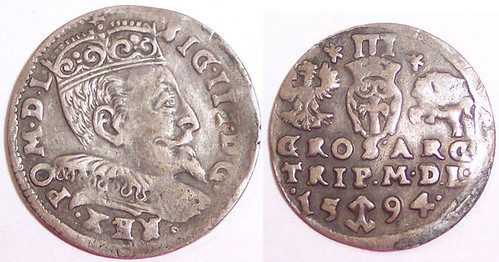
QUERY: INFORMATION ON 'STORY OF MONEY' CARDS SOUGHT
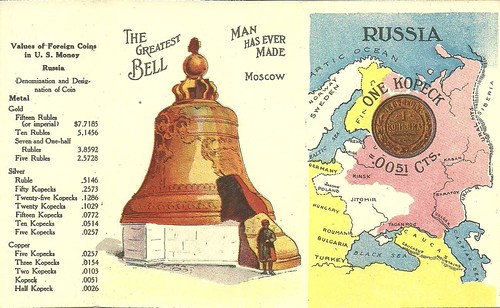
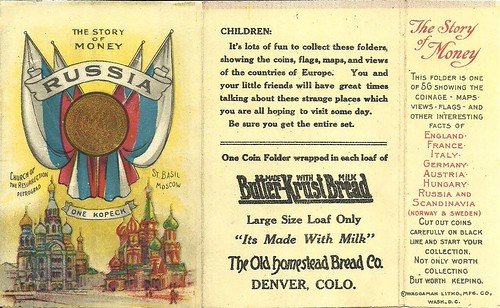
I am looking for information about a series of tri-fold collector cards, called "The Story of Money." The cards were aimed at young children to teach them about the coins of the European nations. Each colour card has information about a specific coin, as well as some images about the nation whence it came. While the children were encouraged to collect the cards, they were also encouraged to cut out the image of the coin from the card to have it for play. (Thereby ruining the card for those of us, many years later, who wish to collect them....alas!)
The cards measure 6-1/2 inches wide by 4 inches high when opened and 2-3/4 inches wide by 4 inches high when folded. As far as I know, there were 56 cards in the series, printed by Waggaman Lithographic Mfg. Inc. of Washington, D.C. I don't know when they were printed, but the cards were obtained through the purchase of a loaf of bread from a bakery that participated in the program. The bakery's information was included on the back of the centre fold in a sponsor area. To date, I have seen only two types of bread/bakeries advertised: Besty Ross Bread from The Whiteside Bakery Co., and Butter Krust Bread from The Old Homestead Bakery Co., Denver. I have also seen cards with the sponsor/baker area blank. On the front of each card, in the lower left or right corner, the card number (between 1-56) was printed in grey ink.
More by good luck than good management, I have thus far been able to acquire 31 of the 56 cards. If any of your readers can help out with information about the series, the list of available cards (nation, denomination, card number), acquisition of the cards themselves, images of the cards, what bakeries distributed the cards, and information about Waggaman, I would be very appreciative. My scouring of the web has yielded very little data so far. I have enclosed an image of the card for the Russian 1 Kopek to assist readers and maybe jog some memories.
MARJORIE OWEN HENDERSHOTT 1924-2013
 Marjorie (Holmes) Owen Hendershott, 89, passed away surrounded by her family at The Village (Indianola, IA), on Tuesday, November 5, 2013.
Marjorie (Holmes) Owen Hendershott, 89, passed away surrounded by her family at The Village (Indianola, IA), on Tuesday, November 5, 2013.
Marjorie was born on August 4, 1924, in Council Bluffs, IA, the daughter of Clarence and Mary (Henshaw) Holmes. She married Lowell L. Owen in 1941 and together they had four children. During their married lives, Lowell and Marjorie lived in several towns throughout Iowa, including Essex, Red Oak, Storm Lake, Arnolds Park, Harlan, and Adel.
With Lowell, Marjorie began her lifelong hobby of numismatics (coin collecting). She became the first female President of the Central States Numismatic Society and was also named a Numismatic Ambassador. Through numismatics, Lowell and Marjorie made many lifelong friends. Lowell passed away in 1976.
In 1983, Marjorie married Robert L. Hendershott, whom she met through their mutual hobby of numismatics. They enjoyed traveling, both in the United States and around the world. Robert and Marjorie lived in Clearwater, FL and Jefferson City, MO before moving to Indianola, IA to be near family. Robert preceded Marjorie in death in 2004.
Marjorie enjoyed life to the fullest. She loved to travel, spend time with family and friends, and sing. She had a wicked sense of humor and enjoyed laughing with a true hearty belly laugh. One of the last stories she told her grandchildren was how she had met their grandfather. They met on the sidewalk in downtown Shenandoah, IA. Lowell and his friend asked Marjorie and her friend to go to a movie with them and they went. Why? Because he was cute and had a car! She laughed at that, like, of course, that is why any young woman in the early 40s dated a man.
Marjorie was an amazing woman. When she decided she was going to do something, she did it with gusto. For example, she and Lowell fell in love just before World War II started. Before Lowell went to war, Marjorie left school and they were married. Marjorie regretted not completing her high school education, so when her youngest son, James, graduated from high school in 1976, Marjorie decided to pursue her G.E.D. She took the tests and completed the entire series in four days!
To read the complete obituary, see: In Memory of Marjorie Owen Hendershott August 4, 1924 - November 5, 2013 (obits.dignitymemorial.com/dignity-memorial/obituary.aspx?n=Marjorie-Hendershott&lc=4511&pid=167913129&mid=5731187&PersonID=167924580)
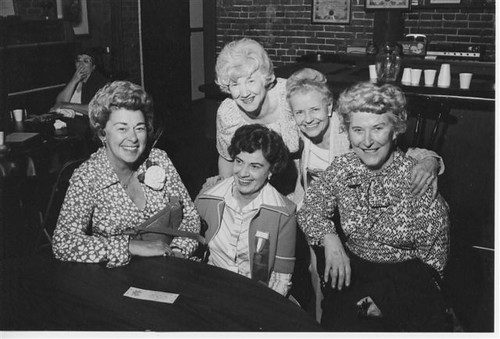
1978 - St. Louis: A bevy of beauties took time out during the ladies' luncheon to pose for The Centinel editor. From the left: Virginia Culver, ANA president; Marjorie M. Owen (seated), CSNS secretary/treasurer; Margo Russell, Coin World editor; Bernice "Bink" Stevenson, '78 CSNS convention chairlady; and Mary Brooks, director of the U. S. Mint. (R. Finner photo)
To read the complete article, see: The History of Central States Part 10 - 1957-1958 (www.centralstates.info/history13.html)
NOTES FROM E-SYLUM READERS: NOVEMBER 17, 2013
Catalog of Current Bi-Metallic Coins Sought Paul Schultz writes:
A co-worker of mine has a need for a list of all (or most) bi-metallic coins currently being issued throughout the world for circulation, not including the NCLT (non circulating legal tender) coins. Do you or any of your E-Sylum readers know of such as list, or a reasonably quick internet site where I could find such a list? This would not be a single alloy of 2 metals, but rather 2 separate metals, as in a center of one metal or alloy plus a ring of another, or even clad coins too. Thanks.
Ford Sale Hardcover Sewn vs Perfect Bindings David Gladfelter writes:
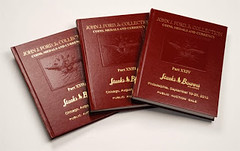 The first 21 Ford sale catalogs were hard bound by Stack’s and sold at $95.00 each. The most recent three sales are hard bound by Stacks-Bowers and are being sold at $50.00 each. The main difference seems to be that the earlier hardbounds have sewn bindings, while the current ones have so-called “perfect” bindings, which are cheaper to produce but less durable in use.
Time will tell which bindings are the better product.
The first 21 Ford sale catalogs were hard bound by Stack’s and sold at $95.00 each. The most recent three sales are hard bound by Stacks-Bowers and are being sold at $50.00 each. The main difference seems to be that the earlier hardbounds have sewn bindings, while the current ones have so-called “perfect” bindings, which are cheaper to produce but less durable in use.
Time will tell which bindings are the better product.
The Bowers & Merena hardbounds are sewn up to the Sussex sale in 1990 except for Taylor sale. Thereafter they are perfect bound except for Frontenac which is sewn. So far they have held together, but next time I open Taylor it will be very carefully.
To read the earlier E-Sylum article, see: HARDCOVER FORD PARTS 22, 23, 24 CATALOGS AVAILABLE (www.coinbooks.org/esylum_v16n44a03.html)
Hartzfeld Fourth Auction Sale Information Sought Roger Burdette writes:
Does anyone have the following in their library? I'm looking for information from S. K. Hartzfeld's, fourth auction sale, March 14, 1879 in Philadelphia. If so, could you look up the Goloid Metric Dollar and let me know the page/lot number and the date on the coin?
The Prince George Christening £5 Coin Gar Travis of Santa Ana, California writes:
I ordered the Prince George Christening £5 coin for a friend who is an Anglophile and Royal watcher. I am sure she will be quite pleased. It was posted from Wales on the 6th and arrived here the 15th.

McKinley on Both Sides of the McKinley Dollars Regarding U.S. coins picturing the same president on BOTH sides of the coin, Bob Van Arsdell writes:
So the first question is "Who's that riding the horse on the 1900 Washington-Lafayette dollar?" No dice – it's Lafayette.
So my nomination for the EARLIEST US coin with the same President on both sides is: the 1916 and 1917 McKinley dollars. They have McKinley's bust on the obverse, and the statue of McKinley in the Niles, Ohio memorial on the reverse.

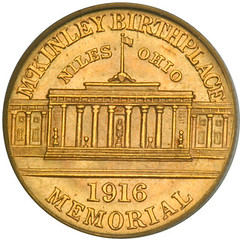
To read the earlier E-Sylum article, see: MOUNT RUSHMORE QUARTER LAUNCH CEREMONY (www.coinbooks.org/esylum_v16n46a14.html)
More on Japanese Occupation of Malaya (Singapore) Book
Dr K.A. Rodgers of New Zealand writes:
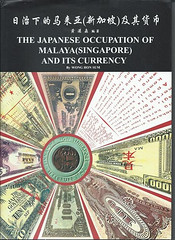
I have Wong’s book. Got one in 1996 when it was published. Reviewed it at the time in Australasian Coin & Banknote. One dealer in Australia was selling copies as I recall. It's a brilliant, scholarly book. Best treatment of Japanese occupation issues I have come across and the illustrations are superb. It is translated from the Chinese in an English that is somewhat of British colonial vintage.
To read the earlier E-Sylum article, see: BOOK REVIEW: JAPANESE OCCUPATION OF MALAYA (SINGAPORE) AND ITS CURRENCY (www.coinbooks.org/esylum_v16n46a06.html)
An "Error" Coin on eBay Mike Paradis writes:
Here is an item listed on eBay. I have seen some wild ones that I had to question if they were serious, this appears to be serious. She has other items listed that are interesting to read.
To read the complete eBay lot description, see: Very Rare Dime With Error (www.ebay.com/itm/Very-Rare-Dime-With-Error-/121208559565)
Videos of Ferguson's 'The Ascent of Money'
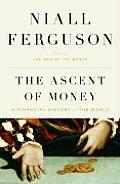 Kavan Ratnatunga forwarded links to videos associated with the book The Ascent of Money:
A Financial History of The World by Niall Ferguson. We reviewed the book in The E-Sylum in 2008.
Kavan Ratnatunga forwarded links to videos associated with the book The Ascent of Money:
A Financial History of The World by Niall Ferguson. We reviewed the book in The E-Sylum in 2008.
To view the videos, see:
The Ascent of Money: A Financial History of The World Parts 1-5
(www.youtube.com/watch?v=4Xx_5PuLIzc)
The Ascent of Money: A Financial History of The World Part 6
(www.youtube.com/watch?v=NZWJ7WPVD_c)
To read the earlier E-Sylum article, see: BOOK REVIEW: THE ASCENT OF MONEY BY NIALL FERGUSON (www.coinbooks.org/esylum_v11n52a03.html)

MORE ON COLLECTOR JOHN G. MILLS
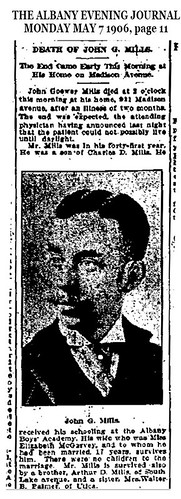
Pete Smith writes:
When I was originally doing research for ANB, I spent months in various libraries looking first at standard biographical publications but also more obscure sources. I paged through every issue of The Numismatist and the American Journal of Numismatics.
I believe that today a person could find more information without leaving their computer. I have never paid for a subscription to one of the services, but I am amazed at what can be found on Ancestry.com and similar sources.
With ANB now available on the NBS site, someone can learn everything I know about an individual by looking at just that site. Then with a little more work they can expand well beyond what I published.
While I have become reasonably proficient at doing research on the web, there are people who are even better. We are fortunate to have some of those people contribute to The E-Sylum.
Pete adds:
While looking for John G. Mills, I learned that he was a pigeon fancier. This reminded me of recent research I was doing on George F. Seavey. He was also a pigeon fancier. Was this common among numismatists? Are there others who pursued both hobbies?
To read the earlier article, see: NOTES FROM E-SYLUM READERS: NOVEMBER 10, 2013 : Robert Coulton Davis Photo (www.coinbooks.org/esylum_v16n46a10.html)
To read Pete Smith's 2012 American Numismatic Biographies, see: www.coinbooks.org/resources/anb_2012.pdf
COLONIAL CURRENCY ON PINS AND NEEDLES
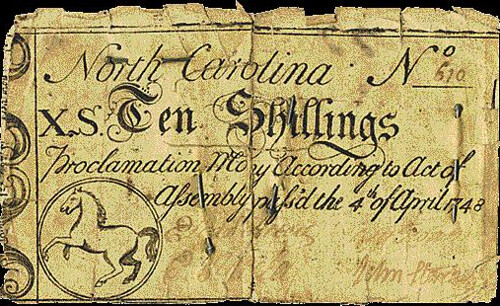
One newfound joy is Colonial and Continental currency. Most Colonial collectors seek notes from each of the 13 colonies (plus Vermont) or from a specific Colony or perhaps Continental issues made by the Continental Congress.
However, I prowl auctions and dealers’ stock for notes that are not pristine examples but rather have survived — barely — in battered and tattered form. Specifically, notes that have been pinned or sewn together.
These notes often circulated until they were literally falling apart.
At that point, emergency restorations were made to keep the notes circulating a bit longer. Two commonly seen approaches are two pieces of a note sewn back together or onto a backing with needle and thread, and notes that were pinned together with straight pins. These notes are typically quite inexpensive because condition conscious collectors tend to shun them as being in “deplorable” condition.
My take on them is somewhat different. They represent wonderful artifacts of our nation’s history, illustrating the extremes to which people would go in order to have some means of conducting trade. The fact that someone took the time some 250 years ago to conserve these notes is the only reason many of them are still with us today.
To read the complete article, see: On pins and needles (www.coinworld.com/articles/on-pins-and-needles)
KING OF SIAM SET PRINTING PLATE BOOK SOUGHT

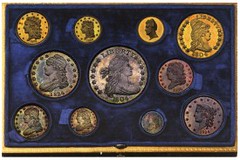
The ad for printing plates reminded me that I recently made a fun purchase. A few weeks ago a seller on eBay had several printing plates that featured illustrations of groups of coins. Most of the subject pieces were of no interest to me, but one quickly caught my eye. The coin images were, of course, mirrored from the way they would appear on the printed page, but I immediately recognized these as the King of Siam proof set. The coin were arrayed just as they appeared in the leather case in which the coins were originally housed before being slabbed; even the gaps for the two missing coins were evident. I must have been the only person who noticed the significance of this one plate, as I bought for the opening bid of just a few dollars, while most of the other plates failed to sell.
The plate measures only 3-3/4" high by 4-1/2" wide and is mounted on a wooden block just slightly larger. The plate is actually oblique, as it shows the coins in a slanted view that would make the right edge of the printed image smaller than the left. I asked the seller if he knew the publication in which this image was used, but he did not. He could tell me only that it was one of many plates retrieved from Whitman Publishing when it vacated its Racine location in 1995.
It would be fun to find a copy of the book or magazine for which this plate was created, and the seller's photo is attached. In the meantime, I'm going to attempt to buy the King of Siam proof set so that I'll have a nice little tie-in item to go with my valuable plate.
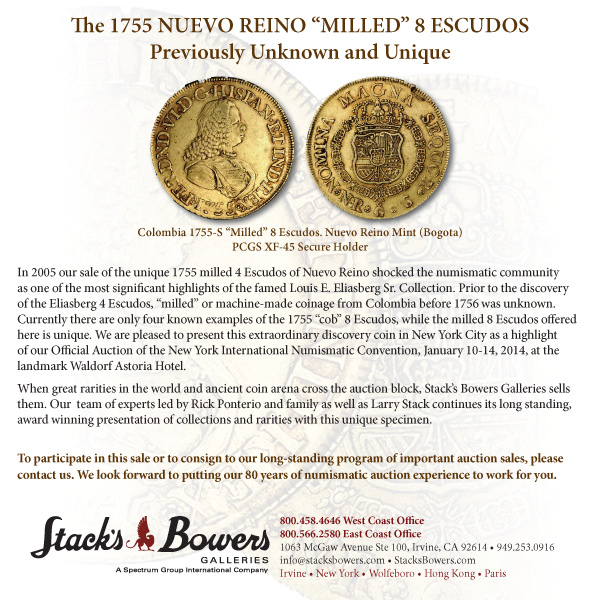
ENGRAVER JOHN BOLEN'S BRAZIL NUT CARVING
In my haste to type out my Baltimore show report last week, I neglected to mention what I examined at length at the Whitman show - undoubtedly the most intriguing and unusual numismatic-related item I'd seen in ages.
A mint state, superbly engraved huge, approx. 3 1/2" x 2" large Brazil nut on a halved Brazil nut stand. The upper portion exposing the white inner nut "meat" , approx. 2 1/2" x 2" , was a skillfully worked, cut and detailed image of a man's full face with detailed protruding teeth, sad eyes and an expression that initially impressed me as being an "Alice in Wonderland" character in the Disney feature film. The cartoonish facial expression was that close.
Turning the masterpiece of nut-engraving over, I noticed the carved- in signature on its base, a prominent JAB monogram dated 1905. It had been acquired on the bourse floor by New England collector/dealer Howard Barron for a not-inconsequential sum and shown to Bolen cataloguer Neil Musante who had a bourse table. Neil verified it was the known work of engraver John Bolen who died a year after this was carved. Neil said Bolen is known to have done other images on nuts in the last years of his life.
Howard said It was not for sale and he treasured it as did I. Surely one of the most unique numismatic-related items I'd ever seen, one more reason to attend shows.
To read the earlier E-Sylum article, see: ALAN WEINBERG'S NOVEMBER 2013 BALTIMORE SHOW REPORT (www.coinbooks.org/esylum_v16n46a20.html)
MORE ON EDWARD SAWYER'S INDIAN MEDALS
 Kudos to the American Numismatic Society for placing the images of the Sawyer Indian galvano medals in their collection on the internet, as mentioned in last week's E-Sylum.
Kudos to the American Numismatic Society for placing the images of the Sawyer Indian galvano medals in their collection on the internet, as mentioned in last week's E-Sylum.
However there is a lot more to the story not mentioned by ANS in their press release. .
Edward Warren Sawyer (1876-1932) traveled to the American West on at least three occasions. He lived with 13 native Indian tribes to gain their confidence to prepare bas-relief clay images of Indian Chiefs, later lesser tribal members.
By 1907 he exhibited five of these portraits at New York's National Academy of Design and exhibited nine at the 1910 International Exhibition of Contemporary Medals at ANS. These galvano casts were made by Henri Weil at a very young Medallic Art Company.
In 1912 Sawyer deposited 31 models with Henri Weil before he left for Paris. I assume the instruction was to make the galvano casts and ship these to the Smithsonian Institution. These were published in the Catalogue of the ...Numismatic Collection of the Mint of the United States by Thomas Comparette. In 1913 the photographs of these 31 galvano medals was deposited for copyright at the Library of Congress.
The collection at the ANS was acquired in 1940. I have published records of 38 different portraits, 28 at both ANS and Smithsonian. ANS has five that the Smithsonian doesn't have; the Smithsonian has four that the ANS doesn't have. There is an early 1904 portrait that neither has.
It is unknown how many are in private collections. Thus this is a series that no one -- public or private -- has them all. I did not catalog the galvanos when I cataloged the medals at Medallic Art. I do remember, however, seeing one Sawyer portrait plaster in oversize (about 14-inch). Perhaps all Sawyer's original models were this size. If so, Henri Weil would have had to make a wax intermediate reduction
For more information you are invited to search on the internet for MEDALBLOG SAWYER'S INDIANS. I wrote this article in 2012 for the new management of Medallic Art Co.
To read the Dick's MedalBlog article, see: Sawyer’s Indians (medalblog.wordpress.com/2010/07/05/sawyer%E2%80%99s-indians/)
To read the earlier E-Sylum article, see: ANS PUBLISHES EDWARD SAWYER’S NATIVE AMERICANS MEDALS ONLINE (www.coinbooks.org/esylum_v16n46a12.html)
SOME NEW COIN DESIGNS: NOVEMBER 17, 2013
Ultramodern numismatist Pabitra Saha continues to compile newly announced or issued coin designs. Here are some that caught my eye in recent weeks.
Finland 2 Euro 2013
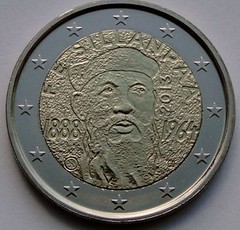
I like the sand-like color and texture on the central portion of this bimetallic piece.
Turkey's Coin on the Ancient City of Sagalassos
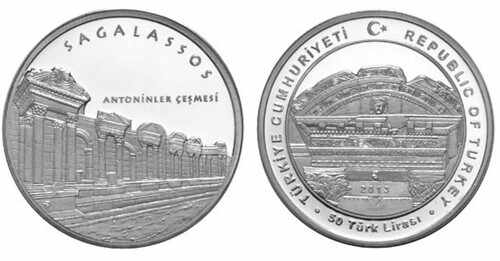
I like the close-up architectural detail on the reverse of this one. One sees a lot of architecture on coins, but rarely this close up.
Kazakhstan Caspian Seal Coin

With this one I like how the seal on the obverse stretches to fill the appropriate oval shape. I don't ordinarily like flat designs like this, but I think it works here. The reverse gives me shivers.
Kazakhstan “Homeland of Apples” Coin
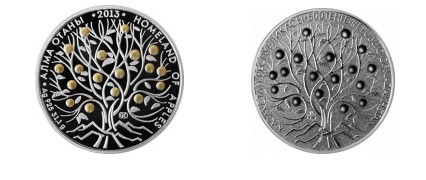
This one has a great three-dimensional look. From the image the apples seem to stick out in very high relief. The tree is too simple and stylized for my tastes, but again, I think the design works here.
Czech Republic 200 Koruna coin on Aloys Klar
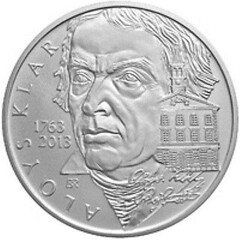

Is that a contraption for printing braille? I'm not sure what it is, but Pabitra's note states that Klar was a philologist. Wikipedia says " Philology is the study of language in written historical sources".
Czech Republic 200 Koruna coin on the Czech National Bank

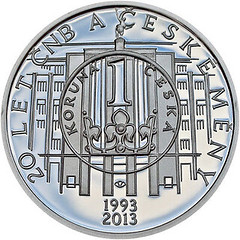
Maybe it’s the toning, but I think this is a really pretty coin. I like the juxtaposition of the traditional rampant lion with Art Deco-like architecture and the coin-within-a-coin.
THE BOOK BAZARRE
AUCTION REVIEW: NUMISMATIK LANZ DECEMBER 2013 SALE
9th December 2013 Numismatik Lanz, Munich Auction sale 157 Numismatic Rarities – Dr. Ferrari Collection, Dr. Sattler Collection
Numismatic Rarities at Lanz
On 9th December, Numismatic Lanz will conduct auction sale no. 157. The Focus are ancient coins, the Habsburg Empire and Italy featuring numerous rarities. Two collections, accumulated over the course of many years, will be liquidated.
Dr. Ernst von Ferrari-Kellerhof (1921-2009) was only twelve years old when he started collecting. His very first coin, a 1683 Leopold-groschen from Hall, created a fascination he was addicted to as long as he lived. In 1968, the specialist in dentistry became co-founder of the Numismatische Vereinigung Bozen, of which he was president at first, and honorary president since 2004. His collection of ancient and, most of all, Italian coins will be liquidated in auction sale 157 by Numismatik Lanz. The second collection containing several rarities from the House of Habsburg and many other areas likewise was put together by a physician, too. Dr. Arnold Sattler (1931-2010), born in Munich in 1931, worked in the USA for many years. His formative experience was a journey in 1965, when he travelled with the Beetle from Vienna via Turkey and Iran to Kabul in Afghanistan where he trained local doctors on behalf of CARE / MEDICO.
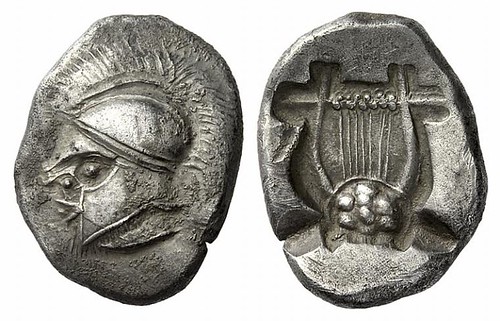
((97 – Thraco-Macedonian tribes. Uncertain mint. Double siglos, c. 500 B. C. Extremely rare. Extremely fine. Estimate: 40,000 euros. Starting price: 24,000 euros.)) 9:30 sharp – that is the time which the 157th sale of Numismatik Lanz in Munich on 9th December 2013 is scheduled for, to be opened by a selection of magnificent Celtic coins. The Greeks are next: be it a nomos from Kaulonia with an impeccable provenance, a tetradrachm from Ainos or a gold stater of Mithradates VI – this sale offers something special for every aficionado of Greek numismatics. An Archaic coin of the Thraco-Macedonian tribes is highly likely to become one of the auction’s highlights, weighing a double siglos and depicting a helmeted head on its obverse and a seven-stringed lyre on its reverse. This coin type is attributed to the island of Kalymna traditionally although there is a good case to associate this piece with the rich Archaic silver coinage of northern Macedonia instead.
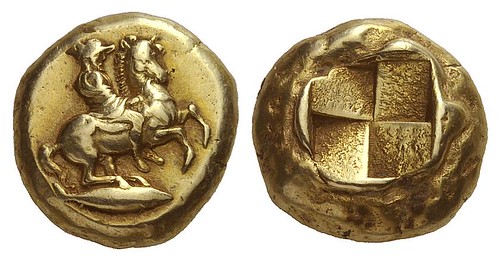
((137 – Cyzicus. El-stater, 460-400. Rare. Very fine. Estimate: 25,000 euros. Starting price: 15,000 euros.)) The entire trade in grain as well as slaves in the Black Sea Region was transacted with electrum coins from Cyzicus for many decades. Lanz offers many examples of this diversified coinage. The piece that stands out the most is an electrum stater whose obverse shows the Heros Kyzikos riding his rearing horse at a gallop to the right. This is the earliest depiction of the Thessalian founder of the famous city located at the Sea of Marmara where the tuna fish catch was so important that the animal became the characteristic feature of this city’s coinage.
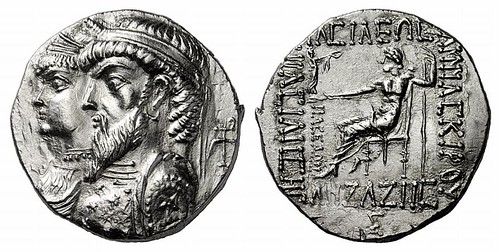
((213 – Elymais. Kamnaskires III and Anzaze, c. 82-74. Tetradrachm, Seleukeia at Hedyphon River. Very rare. Splendid specimen. Estimate: 20,000 euros. Starting price: 12,000 euros.)) Let’s single out just one last rarity from the comprehensive Greek offer, a tetradrachm from King Kamnaskires III of Elymais together with his wife Anzaze. The coin illustrates in a remarkable way how this kingdom in the south-west of Iran was influenced by the Greek AND the Parthian culture. While the double portrait of the royal couple is purely Greek in style, Kamnaskires is shown wearing Iranian garments, hair and beard style. The magnificent preservation of this piece is particularly noteworthy.
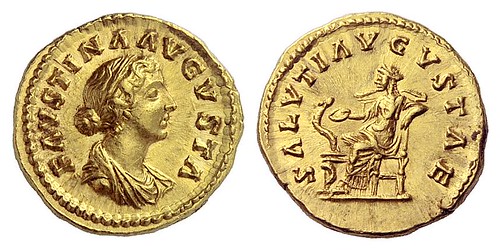
((328 – Faustina II, + 176. Aureus, 161-164. Mint state. E. Beckenbauer Coll. Bankhaus Aufhäuser 5 (1988), 317. Estimate: 15,000 euros. Starting price: 9,000 euros.)) The section of Roman coins is opened by roughly 50 coins from the time of the Roman Republic, with early Aes Grave i. a. from Etruria and Umbria as well as many a rarity from the Roman Civil Wars. More than 100 lots with coins from Roman Imperial times follow. Whether aurei, denarii, antoniniani or bronze coins – there is exciting material for every collector and every budget! The outstanding items are an aureus of Faustina the Younger from the Beckenbauer Collection, an antoninianus of Regalianus from Carnuntum (about extremely fine; estimate: 8,000 euros; starting price: 4,800 euros) and a sestertius of Titus, struck in a mint in the east (Thrace?) in 80 to 81 (extremely fine; estimate: 8,000 euros; starting price: 4,800 euros). By the way, there is a number of exquisitely preserved bronze medallions from the Greek cities under Roman rule dispersed amongst the entire auction!
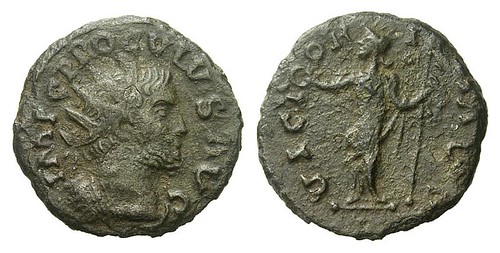
((357 – Proculus, 280-281. Antoninian, c. 280-281, uncertain mint in Gaul or Britannia. Second specimen known to exist. Extremely fine. With export-licence of Arts Council England no. PAU/00206/13. Estimate: 50,000 euros. Starting price: 30,000 euros.))
He who still doubts the existence of Emperor Proculus will be taught better by auction sale Lanz 157. The offered antoninianus of Proculus comes with a solid provenance: the specimen was found on 7th November 2012 on a field not far from Stamford Bridge in East Yorkshire and has been made from the same dies as the example that was auctioned off by Aufhäuser in 1991, now housed in the Staatliche Münzsammlung Munich. The latter coin was sold by an English collector, too, which makes a mint of Proculus located in Britain a likelihood. The ancient section will end with a couple of Byzantine coins, including a solidus of Empress Irene, struck in Syracuse (mint state; estimate: 8,000 euros; starting price: 4,800 euros), and with a large series of coins from the Migration Period, mainly from the empire of the Ostrogoths.
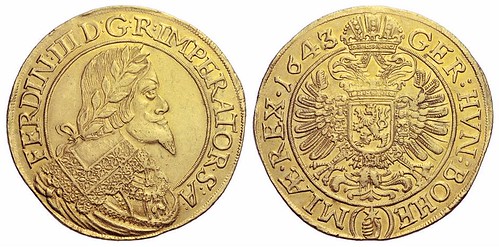
((477 – Habsburg Empire. Ferdinand III, 1637-1657. 10 ducats 1643 (from 1642), Prague. From Hess-Leu 42 (1969), 208. Estimate: 40,000 euros. Starting price: 24,000 euros.)) About 120 lots comprising coins from the vast empire of the Habsburg open the second part of the auction. The connoisseur discovers numerous rarities here as well, like, for example, the 10 ducat piece of Ferdinand III from Prague with the year 1643, that was changed from the original 1642 (very fine; estimate: 40,000 euros; starting price: 24,000 euros) or a broad 5 ducat piece of the Malcontents, struck in Nagybanya in 1703 (very fine; estimate: 5,000 euros; starting price: 3,000 euros). Likewise remarkable is a series of medals from the collection of Albrecht Marquis de Hohenkubin that might also serve as proof that the eminent coin enthusiasts of the past appreciated the medals’ inherent beauty indeed.
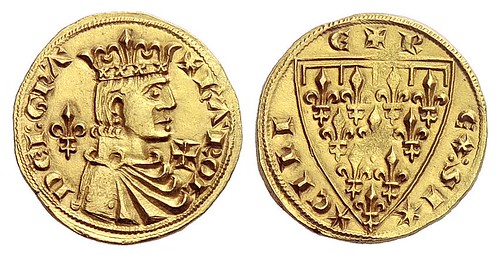
((759 – Italy. Kingdom of Sicily. Charles I of Anjou. Reale d’oro, Barletta. Extremely rare. Extremely fine. Grigoli 4 (1990), 569. Estimate: 25,000 euros. Starting price: 15,000 euros.)) The Holy Roman Empire is followed by the foreign countries represented by roughly 270 lots of which about 120 come from Italy. Their spectrum is extraordinary. Covering everything from Aquileia to Venice, from 100 euros to 25,000, from the early Middles Ages to the Subalpine Republic, the range offers something for virtually every collector. Large series come from Aquileia, Milan and Venice, although other areas come up with notable rarities, too, like a reale d’oro of Charles I of Anjou from Barletta or an extremely rare Venetian ducat of Doge Antonio Grimani (1521-1523) (very fine; estimate: 20,000 euros; starting price: 12,000 euros).
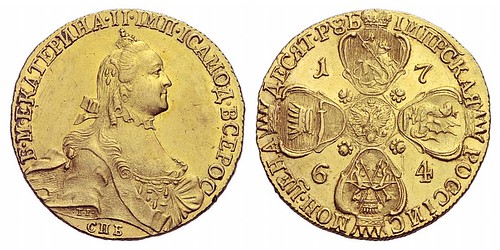
((864 – Russia. Catherine II, 1762-1796. 10 rouble 1764, St. Petersburg. About mint state. Estimate: 15,000 euros. Starting price: 9,000 euros.)) Last but not least, a comprehensive series of Russian coins as well as a small collection of Islamic coins (with one of the zodiac mohurs of Mughal Emperor Jahangir) will be sold.
And please remember! Only those who participate in the Lanz auction sale directly – whether in written form, by telephone, via the internet or in person – are entitled to the generous starting price of 60 %! So, make preparations in time: the auction sale catalog is available at the internet at http://www.sixbid.com/browse.html?auction=1046. If you prefer a paper copy you may request it against a protective fee of 15 euros at Numismatik Lanz, Maximiliansplatz 10, D-80333 Munich, email: info@lanz.com, phone: +49 / 89 / 29 90 70, fax: +49 / 89 / 22 07 62
TOM KAYS' NUMISMATIC DIARY: NOVEMBER 17, 2013
In the group photo that's the dapper Chris Neuzil on the left, followed by Aaron Packard, Jon Radel, Ron Abler and me at the far end in the grey shirt. On the right we see Joe Levine and Lenny Goldberg. Everyone else is obscured, but that's the back of Julian Leidman's head at the far end. He'd been stuck in traffic and arrived late, but settled in and held court from the nearby bar. Other attendees included Gene Brandenburg, Dave Schenkman, Eric Schena, Steve Bishop, and Mike Packard. Ron was our host - his gourmet chef wife helped pick the restaurant, and it was superb. -Editor
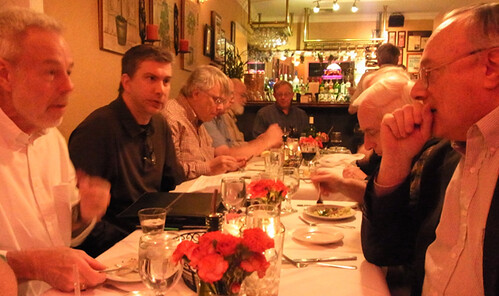
Nummis Nova diners are seen above at VASOs Greek Restaurant, formerly the Dixie Pig, in Alexandria, with Wayne Homren presiding from the vicinity of bar. Tom snapped this table photo inches inside the front picture window, indicating the cozy surroundings, but less than stellar “mood lighting” thwarting professional coin photography. The following pictures were taken directly off the table cloth amid menus, as show-and-tells floated by.
Tom sat far opposite Wayne, and saw these items pass quickly within the first few minutes of the evening, well before we ordered dinner. With so many interesting numismatic items floating along, just a fleeting snapshot is all that would suffice for many, with some of the stories behind the items lost in the din at the far end of the table and only revealed now, in The E-Sylum, if the “shower and teller” took time to tell again what they brought and why they esteem it above others like it.
Some large displays of items must remain a mystery, left to your imagination, such as a collection of pre and post-war wooden money including nickels, double nickels, shillings, and dollars, and a frame of dug, Spanish billion blancas of Ferdinand and Isabella, monogram maravedis of Philip III, Austrian Empire coins with Jamestown era dates and French first empire military buttons (cuffs with regimental numbers) that were present, but went by un-photographed.
Ron Abler announced with grand ceremony and after much clinking of glassware, his release of A Cabinet of Centennial Medals: Exploring the Medals of the 1876 Centennial. He says this achievement launches the start of a numismatic catalog, an “iBook,” a searchable database, a downloadable and printable e-book and a perpetual collaboration with the numismatic public to add any new discoveries of 1876 Centennial material Ron has not yet seen (of which we doubt exists) to be retrofit into the on-line book and released anew in current version with each download staying the most complete possible.
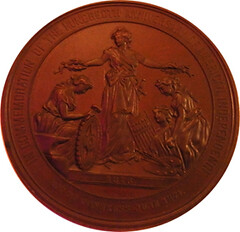
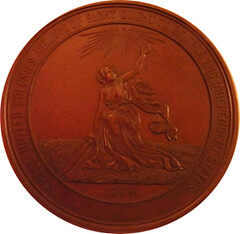
Ron brought and passed around the premiere medal from the 1876 Centennial, the U.S. Centennial Large Commemorative Medal, Variety 1, in Bronze.
Aaron passed around a binder with some beautiful 1850s – 1870s daguerreotype parlor store cards, druggist tokens and even an 1866 Irish Republic, Fenian Brotherhood token.
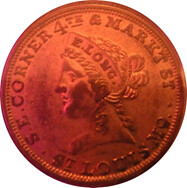
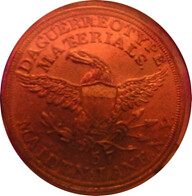
1850s, Saint Louis, Missouri, (Mo–12) E. Long Daguerreotype Materials Token
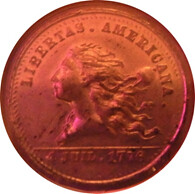
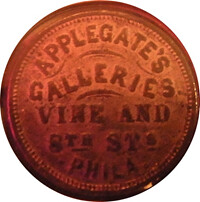
1876 Philadelphia, (PA-830) Applegate’s Galleries Token
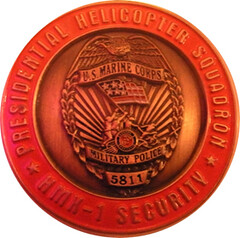

In a reprise of a prior dinner’s theme this unusual Marine Presidential Helicopter Squadron challenge coin made the rounds.
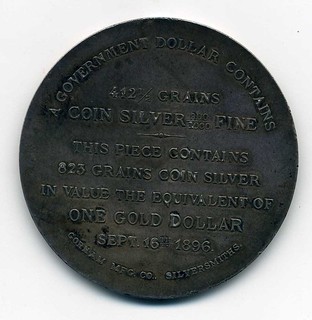
 A Gorham, uniface, So-Called Dollar with William Jennings Bryan’s complements passed by as well, and no, it was not obtained in person, despite the relative maturity of some senior Nummis Nova members and immaturity of others who might think to wonder and ask.
A Gorham, uniface, So-Called Dollar with William Jennings Bryan’s complements passed by as well, and no, it was not obtained in person, despite the relative maturity of some senior Nummis Nova members and immaturity of others who might think to wonder and ask.
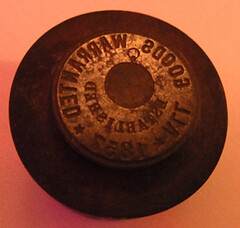
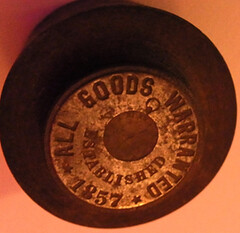
Dave Schenkman passed around a rare die for tokens with “All Goods Warranted” – “Established 1857” and a pocket watch face at center. The image is reversed at right for ease of reading.
Also present was a beautiful and impressive copy of Dr. Philip L. Mossman’s new book “From Crime to Punishment – Counterfeit and Debased Currencies in Colonial and Pre-Federal America” Numismatic Studies 27 by the American Numismatic Society, New York, 2013, now on sale directly from the ANS.


When was this token made?

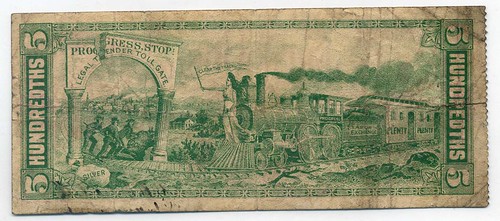
MONOGRAPH SALE
 As 2013 comes to an end, so does the 100th anniversary of the Buffalo nickel. It is appropriate then, to close-out my monograph dedicated to the one and only 1913 Buffalo nickel struck in copper. I have a limited number of the 2011 monograph “A Forgotten Nickel” available for purchase at a price of $5.00 postpaid. It is the story of the Buffalo Nickels that were housed with the five 1913 Liberty Nickels. Told in collaboration with Mr. Eric P. Newman and illustrated with original photographs by the author. Here is a link to the archived
E-Sylum discussion.
As 2013 comes to an end, so does the 100th anniversary of the Buffalo nickel. It is appropriate then, to close-out my monograph dedicated to the one and only 1913 Buffalo nickel struck in copper. I have a limited number of the 2011 monograph “A Forgotten Nickel” available for purchase at a price of $5.00 postpaid. It is the story of the Buffalo Nickels that were housed with the five 1913 Liberty Nickels. Told in collaboration with Mr. Eric P. Newman and illustrated with original photographs by the author. Here is a link to the archived
E-Sylum discussion.
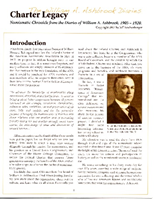 I also have available a small number of my 2007 monograph “Charter Legacy, The William A. Ashbrook Diaries”. This is a chronicle of Ashbrook’s diaries from 1905 to 1920 with an emphasis on the numismatic content and other historic happenings of the period. The price is $5.00 postpaid. Here is a link to the archived
E-Sylum discussion.
I also have available a small number of my 2007 monograph “Charter Legacy, The William A. Ashbrook Diaries”. This is a chronicle of Ashbrook’s diaries from 1905 to 1920 with an emphasis on the numismatic content and other historic happenings of the period. The price is $5.00 postpaid. Here is a link to the archived
E-Sylum discussion.
You can order both items for $9.00 postpaid. Please send an email to reserve a copy: jkreichenberger@hotmail.com First come-first serve, when they’re gone they’re gone.
Jeff Reichenberger
P.O. Box 3572
Oshkosh, WI 54903
BOOKS ON THE PROGRESSIVE LABOR EXCHANGE MOVEMENT
Relating to the topic of Labor Exchange currency in the U.S., Eric Schena writes:
I did some more digging and got a digital copy of DeBernardi's "Trials & Triumphs of Labor," as well as Ernst's "The Progressive Handbook of the Labor Exchange."
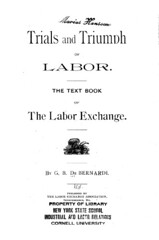
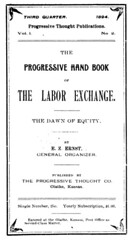
DeBernardi founded the Labor Exchange currency system; his book was published in 1894, as was the Ernst book. It refers to the DeBernardi book and touts the benefits of his system. Basically, it's sales literature directed at potential franchisees of DeBernardi's Labor Exchange system, perhaps not unlike the way Bernard von Nothaus promoted his Liberty Dollar system in more recent times. One passage basically tells readers they would be fools to go it alone:
It is a foolish idea some people get into their heads that they can study up some pln and start a co-operative institution to be a success without adopting the Labor Exchange system. No colony idea can fully succeed. This is the verdict of forty years of study and the world's history for centuries. Why oppose the inevitable when it is truth and light ye seek. Cast aside selfish projects and plant the only complete and effective method man can devise and operate.
Eric kindly forwarded .pdfs for my research files. So other interested readers can access the material as well here are the internet locations where the files can be found. He writes:
Of particular interest for those who collect Labor Exchange notes is that the first few pages have plates with engravings of a labor exchange certificate and an example of a 1/4 denominated note (referred to as a "balance check" by DeBernardi).
To read the Debernardi book online, see: Trials and triumph of labor. The text book of the labor exchange (ebooks.library.cornell.edu/cgi/t/text/text-idx?c=cdl;cc=cdl;view=toc;subview=short;idno=cdl409)
To read the Ernst book online, see:
The Progressive Hand Book of the Labor Exchange: The Dawn of Equity
(books.google.com/books?id=FsFJAAAAIAAJ&pg=PP3&lpg=PP3&dq=Ernst++
The+Progressive+Hand+Book+of+the+Labor+Exchange&source=bl&ots=
fOAh0pT2fO&sig=b58B6BVDfBsflWukSTWsxMxzD0s&hl=en&sa=X&ei=
8ziJUumDIsvrkAfroICIDA&ved=0CDwQ6AEwAg#v=onepage&q=
Ernst%20%20The%20Progressive%20Hand%20Book%20
of%20the%20Labor%20Exchange&f=false)

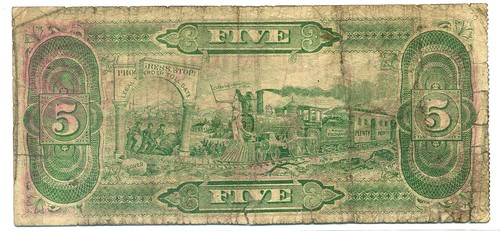
Eric adds:
I am getting on an 1890s kick - such a fantastically interesting era in American history and very numismatically rich.
Kelly Price knows too well the pain of infected teeth and how they become so sensitive it hurts to eat or drink. He has suffered with that in the past and still has several teeth that need to be extracted, but the 51-year-old unemployed machinist can't afford to see a dentist.
That's why on a morning last month he was helping out at the Food Bank of South Central Michigan filling bags for weekend meals for needy children with Special K cereal, cans of spaghetti and meatballs, green beans and a juice drink.
The hours Price volunteers inside the sprawling warehouse in "cereal city" will help him get to see a dentist for free. "I would rather pay with cash, but if this is the only way I can do it (that's) fine because I am helping someone else and it all works out," he said.
Price is one of the more than 4,000 adults who since 2007 have received care under the Calhoun County Dentists' Partnership — a privately financed program that requires patients to perform some volunteer work to qualify for the free dental services. The "pay it forward" model enables low-income, uninsured patients to earn their care by helping local non-profits, including the local homeless shelter, Red Cross and Salvation Army.
To read the complete article, see: Will work for dental: A new health care model? (www.usatoday.com/story/news/nation/2013/11/16/dental-health-care-michigan/3469259/)
SRI LANKA ISSUES NEW COMMEMORATIVE 500 RUPEE NOTE
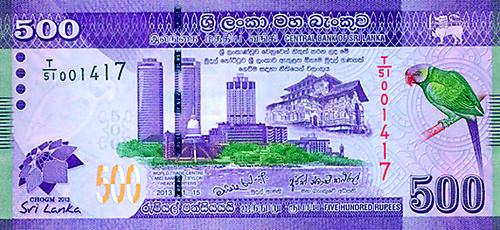
The Central Bank of Sri Lanka (CB) on 2013 November 15th issued a slightly modified Rs. 500 currency note as a commemorative to mark the Commonwealth Heads of Government Meeting (CHOGM) in Sri Lanka.
The size and design of the Commemorative note are same with only the CHOGM 2013 Sri Lanka logo in single purple colour replacing the butterfly at the lower left corner of the note, and a new date of issue 2013.11.15. The vertical 500 of the water mark has an additional design on either side to enhance security features. CBSL has already printed 50 million of the current 2010 Rs500 note and the 5 million commemoratives will have serial prefix T/51 to T/55.
Host countries of previous CHOGMs have also issued such commemorative numismatic items. In 2007 the Bank of Uganda issued a sh10,000, and in 2009 Trinidad And Tobago a $100 Currency Notes. In 2011 the Royal Australian Mint issued a one dollar coin. The Sri Lankan note appears to be a rush job since final approval from the Monetary Board only happened after August when a rumour of this note first circulated. Printing the logo in only purple was probably done modifying the final Purple Integlo print rather than four plates required for a multicolor logo.
The CB Museum in Rajagiriya is now closed after renovation just four years ago. The Centre Point Building has been beautifully renovated by the CB. Located next to the Light House clock tower at 54 Chatham Street, it was opened by the President on November 11th. The Museum looks modern, but the display put up in just one weekend, needs to be rearranged properly.
A 150 page book titled “From Purana to the Rupee” published by the CB and sold at the Museum does not appear to have been proof-read by anyone competent in Lankan history or Numismatics.
To read the complete article, see: New CHOGM Rs. 500 currency note (www.sundaytimes.lk/131117/business-times/new-chogm-rs-500-currency-note-73260.html)
Kavan adds:
More details are in notes.lakdiva.org/commemorative/2013_chogm_500r.html and also issued the First dutch minted coin to circulate in Lanka after 200 years. See coins.lakdiva.org/srilanka/srilanka_r02_fe.html
OLYMPIC COMMITTEE NIXES MEDALS STRUCK FROM CANCELLED DIES

I found your article via the web. It discussed the company Quality Silver Bullion and how they minted a series of 100 sets of medals with a cancelled 1995 Atlanta Olympic die. I just wanted to let you know that they are now selling the dies via eBay and it sounds like they ran into problems with the USOC and the series was cancelled. It would be interesting to see how many medal sets made it into public hands before the series was cancelled. My estimates show 24 sets were sold; data from their last eBay sale stated the following: NOTE: SETS 2-11; 13; 20; 24; 26; 30; 47; 50; 60; 80; 88; 95, 96; 99 and 100 HAVE BEEN SOLD.
The eBay listing states:
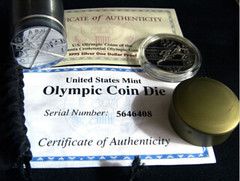 Cancelled 1995 Proof Atlanta Olympics Track & Field Die - As seen in Coin World Magazine! Die number P5-646408.
Cancelled 1995 Proof Atlanta Olympics Track & Field Die - As seen in Coin World Magazine! Die number P5-646408.
Used to strike Silver, Silver/Copper and Silver/Brass Bimetallic Medals.
See our other items for the Cancelled Reverse Die.
Items included in this sale are: the cancelled die; the original gold plastic cap and black velour bag; Certificate of Authenticity; a Genuine 1995-P Proof Track & Field Silver Dollar with its original mint packaging and certificate.
The medals shown are not for sale - they are only to display the medals that were struck using this die and the reverse engraved by us.
The sale of the medals was discontinued by request of the United States Olympic Committee (USOC).
Phantom50 adds:
I did talk to the representative via eBay and he confirmed that there were only 24 sets sold and the winning buyer of the Atlanta die will be able to replace their numbered set with the one marked #001 (if they purchased one of the 24 sets, he stated.)
I'm just curious about this whole deal because I find it odd that the USOC now has a problem with the dies being used, as it somewhat sets a precedence for all of the other dies that were sold in 1997. I'm just a collector and found the attempt of QSB to be rather interesting. And being one of the (lucky?) 24 people to buy a set originally, I find the whole outcome here to be quite interesting.
Hopefully more of the story will come out as I enjoyed your article and CoinWorld's article on the subject. It looked like all the legal hurdles were settled, but now that the USOC decided against the use of their logo/rings it would great to have a follow-up on the subject.
To read the complete eBay lot description, see: 1995-P ATLANTA OLYMPICS Track & Field Cancelled Die - w/Proof Silver Dollar (www.ebay.com/itm/1995-P-ATLANTA-OLYMPICS-Track-Field-Cancelled-Die-w-Proof-Silver-Dollar-/321249453339?)
To read the earlier E-Sylum articles, see:
MEDALS STRUCK WITH CANCELLED 1995 OLYMPIC DOLLAR DIE
(www.coinbooks.org/esylum_v16n38a19.html)
ON THE LEGALITY OF USING CANCELLED MINT DIES
(www.coinbooks.org/esylum_v16n41a10.html)
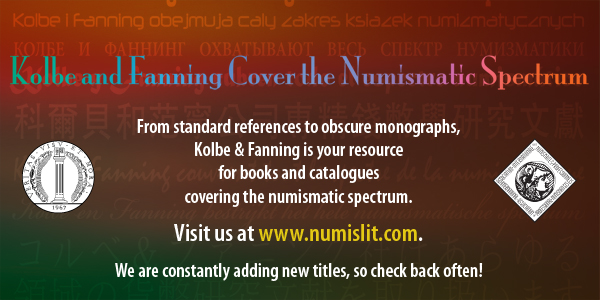
TWO NEW NUMISMATIC MUSEUM GALLERIES PLANNED IN INDIA
The Salar Jung and the State Museum are all set to add a new feather to their caps, with a dedicated Numismatic gallery each.
A collection of over 2 lakh coins will go on display at the State Museum and Salar Jung will treasure 1,800 coins.
The coins belong to various dynasties like the Satavahana, VishnuKundina, Shatrupaksha, Gupta and the collection even includes early punch marked currency.
Authorities from the State department of Archeology and Museums said, the semi-circled Numismatics Gallery being set up on the ground floor of the museum and will include coins from second century BC— punch marked coins made of silver and copper. These form the earliest currencies found in Andhra Pradesh.
The gallery will also display Satavahana (made of lead and potian), VishnuKundina, Gupta, Mughal, Thuglakera coins. Most of the coins were unearthed from Kurnool, Mahbubnagar, Khammam and Vizianagaram. The recent find of 90 silver coins from Medak district have also been included.
“Besides the British Museum, the AP State Museum, which is the oldest in the state, is the one that has a plentiful collection of coins, making it the second largest collection in the world. It has about 14,000 gold coins, and around 1,00,000 silver, lead, and copper coins from different dynasties of AP. The department has also sanctioned Rs 50 lakh towards this gallery,” officials added
Meanwhile, A. Nagender Reddy, director of Salar Jung Museum, said, “The gallery will be set up in the central block and Rs 10 lakh have been sanctioned for the process.”
According to officials, the showcases are being prepared by a private company and will feature bullet-proof cabinets and other security features. Additional metal detectors and CCTV’s will soon be installed at the numismatics galleries at both museums. Visitors can also look forward to a section which will give them information on various technologies that were used in the minting of coins in the different eras.
Besides the funds and technical additions, the Reserve Bank of India has also donated an information kiosk and a television to the Salar Jung Museum. The kiosk will explain various aspects of ancient Indian coins and currency notes and the TV set will display the topic, “The story of Indian paper money, know your bank notes”, aimed at educating visitors.
To read the complete article, see: Salar Jung, State Museum set to get coin galleries (www.deccanchronicle.com/131110/news-current-affairs/article/salar-jung-state-museum-set-get-coin-galleries)
MEDAL SLEUTH LOCATES MILITARY CROSS FAMILY MEMBERS
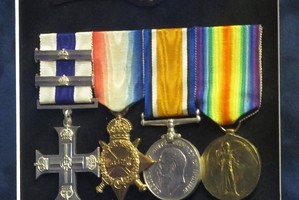 Alfred Youdale's medals. The rare Military Cross with Two Bars is on the left.
Alfred Youdale's medals. The rare Military Cross with Two Bars is on the left.
Four years ago Russell RSA member Peter Roberts was sorting through medals donated to the club when he came across a rare Military Cross with Two Bars. Only nine were awarded worldwide in WWI.
Determined to give the medal and its original owner the respect they deserved, Mr Roberts and his wife Barbara set about finding out who it had been awarded to. That proved surprisingly difficult, not least because the name had been scratched off.
After years of research, inquiries to museums and experts and even forensic testing, the couple established the medal had been awarded to Australian Alfred Youdale for bravery in the skies of France and Belgium. He died in 1917 before he had a chance to wear it.
The couple then set about contacting all the Youdales they could find in the Sydney suburb where he was born, until they finally found a great-nephew who thought the medal was in the Imperial War Museum in London.
Even the Roberts' sleuthing abilities have not been able to solve the mystery of how the medal ended up in Russell, a town with which Alfred Youdale had no known connection.
On Monday, Armistice Day, four members of Alfred Youdale's family flew from Sydney to attend a formal unveiling of his Military Cross with Two Bars and accompanying service medals in a purpose-built display case at the Russell RSA.
An emotional Mr Roberts said there were two tragedies to Alfred Youdale's story.
''First, that Alf was killed in action on December 23, 1917. Second, he never got to wear these medals.''
To read the complete article, see: Rare medal's mystery ends (www.nzherald.co.nz/northern-advocate/news/article.cfm?c_id=1503450&objectid=11157103)
1640 BAY PSALM BOOK TO BE SOLD BY SOTHEBY’S
Tom Fort writes:
While it is not a numismatic work, nevertheless, I thought that this article about what may be the world's most expensive book would be of interest to readers.
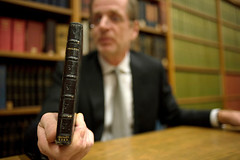 David N. Redden recited the opening of the 23rd Psalm the way he had memorized it as a child: “The Lord is my shepherd; I shall not want. He maketh me to lie down in green pastures.”
David N. Redden recited the opening of the 23rd Psalm the way he had memorized it as a child: “The Lord is my shepherd; I shall not want. He maketh me to lie down in green pastures.”
Then he opened a weathered little book and read the version it contained: “The Lord to mee a ∫hepheard is, want therefore ∫hall not I. Hee in the fold∫ of tender-gra∫∫e, doth cau∫e mee downe to lie.”
Those lines were in a volume published in Massachusetts in 1640 that amounted to the Puritans’ religious and cultural manifesto. It was the first book printed in the colonies, and the first book printed in English in the New World. The locksmith who ran the hand-operated press turned out roughly 1,700 copies. The one in Mr. Redden’s hands is one of only 11 known to exist.
Mr. Redden, who is the chairman of Sotheby’s books department and has auctioned copies of Magna Carta and the Declaration of Independence, among other historic and valuable documents, will sell that copy on Nov. 26. Sotheby’s expects it to go for $15 million to $30 million, which would make it the most expensive book ever sold at auction.
To read the complete article, see: Let Bidding Begin for the Bay Psalm Book From 1640 (www.nytimes.com/2013/11/16/nyregion/let-bidding-begin-for-the-bay-psalm-book-from-1640.html)
To read the earlier E-Sylum article, see: 1640 BAY PSALM BOOK TO BE AUCTIONED (www.coinbooks.org/esylum_v16n15a23.html)
THE BOOK BAZARRE
2014 COIN OF THE YEAR WINNERS ANNOUNCED
Voting took place by secret electronic ballot in ten categories by an international panel of judges from the 31st October to the 10th November. A nominating committee met in the offices of World Coin News in Iola, Wisconsin USA on the 4th October and placed a total of 99 coins in the first round of the COTY ballot. All coins in the competition are dated 2012 and nominations were submitted by anyone wishing to bring attention to their favorite coin or coins.
In the first round of ballots, France and Australia were the top two contenders for the 2014 Coin of the Year Award sponsored by World Coin News gaining awards for two categories each respectively. Greece, with its three nominations in separate categories, was also recognized for its excellence.
Yves Klein 10-euro silver coin
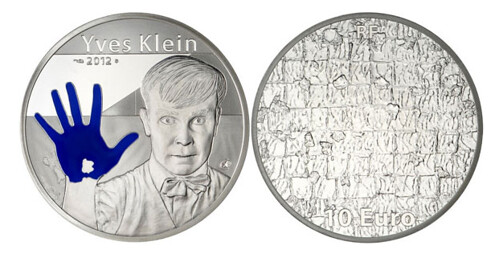
France was recognized in the “Most Artistic coin category for the Yves Klein 10-euro silver coin, (KM-2087). Its distinctive blue hand of the artist against the silver background received top honors.
“Helsinki - World Design Capital” 50 Euro coin
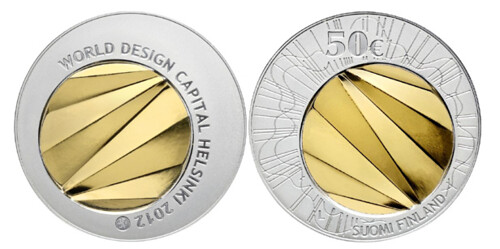
The Best Bi-Metallic Coin category was awarded to Finland for the “Helsinki - World Design Capital” 50 Euro coin. The outer ring of this innovative design was minted in silver with an inner disc minted in gold (KM-180).
To read the complete article, see: Krause Publications Announces 2014 Coin of the Year Award Winners (news.coinupdate.com/krause-publications-announces-coin-of-the-year-award-winners-3030/)
LEBANESE BANKNOTE MISSPELLS 'INDEPENDENCE'
Lebanon will go ahead with plans to issue banknotes marking 70 years since its independence despite a spelling mistake on the commemorative currency, the Central Bank said on Friday.
The French-language face of the special issue 50,000 pound note, which is worth about $33, spells "independence" as it is written in English, rather than the French "independance".
The bank said it regretted the mistake, which it blamed on the printing company, but said the notes would still go into circulation next Friday, when Lebanon marks the anniversary of the end of French colonial rule in 1943.
To read the complete article, see: Lebanese banknote celebrates independence - but can't spell it (www.reuters.com/article/2013/11/15/lebanon-currency-idUSL5N0J032M20131115)
I found this article about the same note, and this one has images. The word "independence" in English is on the back, below the large number 70.
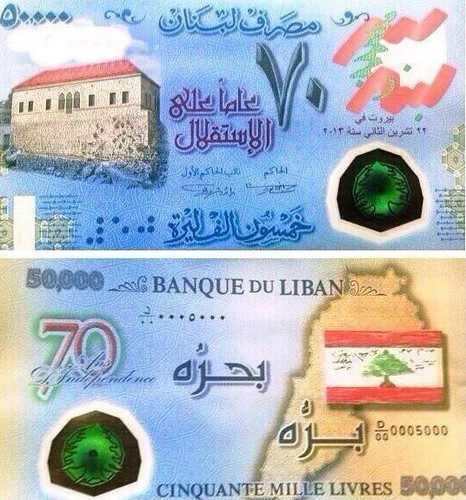
To read the complete article, see: Lebanon's new 50,000 LL bank note a "Photoshop massacre" (english.al-akhbar.com/content/lebanons-new-50000-ll-bank-note-photoshop-massacre)
THE 1859 JOHN J. FORD BOSTON SCHOOL MEDAL
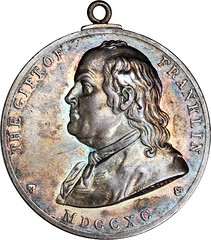
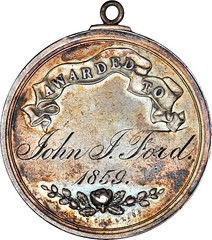
Lot #21295. 1859 Boston School Medal. Silver. 34 Mm. Fuld FR.M.BO.11, Greenslet GM-359, Julian SC-11. Extremely Fine.
Awarded to John J. Ford. Original suspension mount on rim at 12 o'clock. An almost impossible coincidence, engraved to a boy in Boston before the Civil War with the same name as the man who formed this collection. Beautifully toned in rainbow shades of blue, gold, rose, and more. Some light wear and handling. Struck at the U.S. Mint.
From the John J. Ford, Jr. Collection. Earlier from the New Netherlands Coin Company on June 2, 1960. Even earlier from Dr. Thomas Hall to Virgil Brand in 1909; Brand Estate to B.G. Johnson on May 22, 1935; Brand Estate to New Netherlands Coin Company. Paper envelope included.
To view the complete lot description, see: Lot #21295. 1859 Boston School Medal. Silver. 34 Mm. (stacksbowers.com/auctions/AuctionLot.aspx?LotID=529013)
FEATURED WEB PAGE: A CENTENNIAL CABINET
This week's Featured Web Page is Ron Abler's new site, A Centennial Cabinet: Exploring the Exonumia of the 1876 U.S. Centennial. The site is the online home of his new book on centennial medals.Welcome to the Centennial Medals Cabinet! My intent for this website is to share with all collectors the information about 1876 Centennial medals that I have learned since starting to collect these lovely and interesting bits of historical sculpture. I also hope that this website will become a central point for my fellow collectors to share with me and each other their knowledge about Centennial medals. With your help and through your collaboration, we can make this site the most complete and comprehensive reference possible.
Believe it or not, the last attempts at a comprehensive catalog of Centennial medals were in 1876! In that year, William Holland serialized his catalog in several consecutive issues of the American Journal of Numismatics (AJN), and Edouard Frossard did the same in the Coin Collectors Journal (CCJ).
Many authors in the last 230-plus years have included Centennial medals in their catalogs, but only peripherally, never comprehensively. Thus, most of the Centennial medals that depict George Washington can be found in the Russell Rulau’s and George Fuld’s excellent redux Baker work in Medallic Portraits of Washington. There are two chapters that include Centennial medals in R.W. Julian’s Medals of the United States Mint. Bill Swoger’s recent tome on National Commemorative Medals covers the Centennial Commemorative Medals in great detail. And then there’s Hibler-Kappen’s book on So Called Dollars that includes many Centennial medals (as long as they are about the size of a silver dollar). A casual glance at the Bibliography in the Appendices will give you an idea of just how many authors have dabbled in Centennial medals, but this cabinet is the first to concentrate exclusively on Centennial medals since 1876.
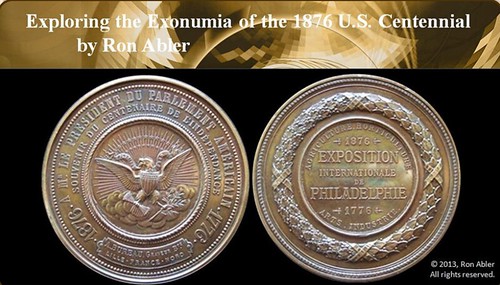
www.centennialmedals.com
